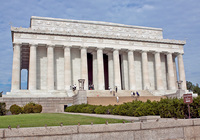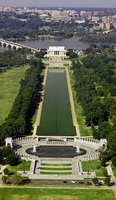We just arrived home a little less than 24 hours ago from a (too-short) week in South Dakota.
We flew in to Rapid City, on the western edge of the state, and used this as a jumping off point for trips to some wonders of nature (the Badlands, Devil’s Tower) and to some not-so-natural wonders: Mount Rushmore, Crazy Horse memorial, Rapid City itself.
I’ll be updating this entry as I process more data; best – after the fact – to have just one entry.
Before I forget – This was the first real (not just overnight or day trip) vacation I’ve taken with a smartphone. All I can say is this: How the frick did I get by without one? Mapping, calling restaurants, taking pics, looking up info…incredible. I cannot overemphasize how useful it is on a trip. Mind-blowing.
Rapid City
Yes, Rapid City was our “point of origin,” and we stayed at a very nice hotel: Hotel Alex Johnson, an old hotel that is undergoing renovations and is pretty much visible throughout the city. (Hotel Alex Johnson’s website) Only 11 stories tall, the hotel pretty much dominates the downtown area, with only a couple of other (newer) building rising more than a few stories tall.
The Vertex Bar sits on top of the hotel, and it’s a members’ only club: But hotel guests get access. Score! Pricey, but great views and it’s just nice to sit on the roof, enjoy the nightfall and have a martini. Sounds good, yes?
The room we had – a suite – was small, but for us, that’s fine. The hotel room is just a jumping-off point. But it was on the 8th floor, with a western view (toward the foothills of the Black Hills). Nothing to really write home about, but the history of the hotel, the motifs (American Indian/German – go figger), and it’s location made it a winner.
I’m glad we stayed there. This is – to me – “the” place to stay in Rapid City, and we’ll never be in the town again. Good choice.
Rapid City itself – overall – is pretty much a nothingburger. There are approximately four blocks (to be generous) around the Hotel Alex Johnson that maintain the old Rapid City looks, but that’s about it. And while the city seems to be trying to keep the downtown alive (parking garage, corner park in the historic district with frequent events), I don’t have a whole lot of hope. Just driving in and out of the city, we ran across wide swaths of “outlying” areas that are in the midst of construction booms. Think large malls, Walmarts, lumber yards, restaurants (nice and chain). This is going to steal from the downtown area, the little that’s left.
Kinda sad.
That said, the historic district – mainly Main and St. Joseph streets, bounded east and west by 5th and 7th streets, respectively – had some interesting architecture and some nice restaurants/watering holes.
Mount Rushmore National Memorial
OK, let’s be honest: Probably the main reason tourists come to South Dakota is for Mount Rushmore.
Is it a tourist-centric National Memorial? Sure.
And is it pretty much just the carved heads in the hills? Pretty much, except for the stray mountain goat (there were two, and they were like cats in second-hand bookstores: They didn’t pay any mind to the people milling about).
That said, it’s pretty impressive. They have a nice parking garage, neat paths and so on. Very clean and with not a lot of fuss. Yes, there is a walkway with shops and all, but it’s at a respectful distance from the mountain.
Everyone should do it once.
Crazy Horse Memorial
While I really didn’t have any expectation for this other mountain-carving locale south of Mount Rushmore, I was still let down.
This is a private facility, devoted to creating a huge center of Native American culture/study and so on. They have very ambitious plans – which is to be commended – but not much there there yet.
The mountain carving began in 1948 – that’s 65 years ago, and they really don’t have much to show for it. Mount Rushmore, as a comparison, was started in 1927 and was done (as it is today) a dozen years later.
They did have a Native American museum with pictures/artifacts of tribes from all over North America; I can’t say if it’s good collection or not, but it was fun to look at – especially the drawings and photos of Indian tribe leaders.
Give this one a pass unless you’re a Native American buff.
The Badlands National Park
Two important data points about South Dakota’s Badland National Park:
- Aptly named. There are prairie parts – potentially for grazing or farming (were it not public land…), but for the most part, it’s like a geological museum. Erosion is the keyword, yet the erosion varies depending on where you look.
- Not much to the park beyond the (varied) eroding hills. Little wildlife; few plants beyond grass/short scrubby plants. Unless you enjoy looking at rock formations, you’re probably going to want to take a pass at this park.
I really enjoy looking at rocks and so on, so – for me – the day we spent at the Badlands was – overall – the highlight of the trip.
We got there early, had good light (important to me for photography) early on, though it got a mixed sunshine/overcast as the day went on. And by the time we were getting ready to head out of there, the traffic had begun to ramp up. We pretty much hit it just right.
The Badlands is pretty much just an area with geology that is making the hills melt (or not) at differing degrees. Lots of hills that look like wedding cakes left out in the rain. Very uneven “melting,” shall we say.
There is surprisingly little wildlife for such a big park, but that’s – again – geological. It’s basically a park that’s an enormous tribute to sedimentary rocks. Much like the Grand Canyon, it’s all about eroding rocks. (NOTE: From my one trip to both parks, the Grand Canyon has way more wildlife than the Badlands, probably due to the sparseness of water and plants in the Badlands vs. the Grand Canyon).
Unlike the Grand Canyon, the Badlands is not a uniform erosion. It’s eroding at different degrees, sometimes right next to the other. That’s what make the rock formations there so wild.
 In keeping with the “it’s eroding at different degrees, sometimes right next to the other” statement above, I can expand this (and offer photographic support) that there will be this canyon a hundred yards deep…next to miles of prairie. It happens all over the place in the Badlands; it’s quite the sight to see.
In keeping with the “it’s eroding at different degrees, sometimes right next to the other” statement above, I can expand this (and offer photographic support) that there will be this canyon a hundred yards deep…next to miles of prairie. It happens all over the place in the Badlands; it’s quite the sight to see.
Of all the places we went to during our South Dakota trip, I think I’d like to go back to the Badlands again – but only for photography (learn the place so you capture the sunrise on this hill; do it with infrared; multiple lens [wide/telephoto] selection). Will probably never happen, but – unlike Mount Rushmore National Memorial – I’d like to do it again.
This is a National Park that I’ll probably DIS-recommend to pretty much anyone that doesn’t like…rocks and no Dairy Queens. Me? I likes.
Devils Tower National Monument
On our third day, we ventured northwest across the state line into Wyoming, to see – among other things – Devils Tower National Monument.
Devils Tower (the name seems to be non-posessive) is a remarkable presence. Rising out of modest hills, this large cylinder of igneous rock towers above all around it, and it is unlike all other rocks/hills around it.
It looks like the state of Wyoming is giving a giant “thumbs up!” to something. Remarkable rock. Facebook should buy the state and rename Devils Tower the “Like” tower.
There’s really not much to the area – just the tower, for the most part. And so I’m not going to apologize for all the different views of the tower in my gallery – it’s a photogenic mass, and there’s not much else. OK?
Spearfish, Lead and Spearfish Canyon (and Sturgis)
On the trip back from Devils Tower, we stopped – briefly – in the towns of Spearfish, Lead and Sturgis, and drove back home through the Black Hills National Forest area known as Spearfish Canyon.
Spearfish: We stopped in Spearfish just to have some breakfast/lunch (we left Rapid City early to get to Devils Tower early, a winning strategy!). Nice, very clean city with some nice old architecture in the town center. But nothing remarkable about it beyond that.
Lead: I’m assuming they also mined lead around here, but The Homestake Mine is a deep underground gold mine located in Lead, South Dakota. Until it closed in 2002 it was the largest and deepest gold mine in North America. Before that, it was a deep open-pit mine. And that’s what I wanted to see – the big hole in the ground. You can’t really get close enough to get the real impact, but, still, impressive. Romy was “meh”; maybe it’s a guy thing (massive anything).
Lead seems to be trying to move past its mining past (while capitalizing on that history, obviously) to a more “slice of the Old West” gentrification. Right now, a mixed bag. We went to a new bar (in an OLD building) that’s part of the gentrification; I wish them well. But I dunno. And why I didn’t buy a T-shirt from the bar – Bumping Buffalo – escapes me. I’m an idiot.
Sturgis: Let’s get this out of the way. The motorcycle-centric town had…no cycle events going when we went there: It was a small, ugly, empty town. Maybe when the Harleys roll in it changes, but what we saw was unimpressive.
Spearfish Canyon Here’s how Wikipedia describes Spearfish Canyon:
Spearfish Canyon is a deep but narrow gorge carved by Spearfish Creek just south of Spearfish, South Dakota in the U.S. It is located on the northern edge of Black Hills National Forest.
From Lead to Sturgis (bleh), we went on State Route 14 through Spearfish Canyon. Not spectacular, but fun and a nice change of pace.
One of the more interesting parts of the drive was that it involved water – yeah, H20 – something that just isn’t around in that part of South Dakota. Just a creek, but a change. Compared to the day Black Hills and Badlands, it almost reminded me of Cornell, with it’s gorges and such – but here, mainly conifers. Upstate NY (Ithaca) was mainly deciduous trees. Hmmm.
Overall, Spearfish Canyon is a nice scenic drive, but nothing special. I liked the small waterfalls and cliff walls, but they are nothing compared to Devils Tower or the Badlands. But that’s me; your mileage may differ (YMMD).
Custer State Park
This trip – SW of Rapid City – was all Romy’s idea, and it was great.
Romy wanted to see bison; we got same.
But the park was nice mix of Black Hill and prairie – the Coolidge Tower was just a bonus (wow!). At an elevation of around 6,000 feet, Coolidge Tower – built largely with elbow grease in the 1930s – affords a 360° view of the Black Hills that surround it, at an elevation of at least 500 feet above all (Coolidge was built as – and may well still serve – as a fire lookout station). The views north and west allow you to pick out Mount Rushmore, as well as Crazy Horse. Pretty impressive.
Lots of wildlife in the area – bison, antelope, burros(!), but with the exception of a random crow, very few birds, even when we got out of the prairie regions of Custer and more in the Ponderosa pined Black Hills. Eerily quiet.
Well worth a visit if you’re into big empty spaces and no gift shoppes. You have been warned.

 Well, we lost Jack today – he was never really ours, but I hope that over the last year and a half, we made his life as cat-happy as possible.
Well, we lost Jack today – he was never really ours, but I hope that over the last year and a half, we made his life as cat-happy as possible. 





























 House of Cards
House of Cards


 Veep Season One
Veep Season One Damages – Season 5
Damages – Season 5